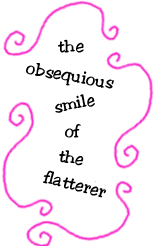 I just saw a program on Botox treatments, and boy does that look weird. No matter how many books I read on the subject of beauty, it’s still hard to understand the extent that folks will mutilate themselves for the sake of it all.
I just saw a program on Botox treatments, and boy does that look weird. No matter how many books I read on the subject of beauty, it’s still hard to understand the extent that folks will mutilate themselves for the sake of it all.
Although I personally would never get a treatment such as that, I don’t want to discriminate against those who would. I hear that one of the side effects is the inability to show a variety of expressions. To help those who may, during their treatment period, forget why a smile is a good thing, I turn to this excerpt from Bits of Talk About Home Matters. Just doing my part for society.
1895: The Fine Art of Smiling
![]() The purely natural smile . . . is seldom seen in adults; and it is on this point that we wish to dwell. Very early in life people find out that a smile is a weapon, mighty to avail in all sorts of crises. Hence, we see the treacherous smile of the wily; the patronizing smile of the pompous; the obsequious smile of the flatterer; the cynical smile of the satirist. . . . All such smiles are hideous. The gloomiest, blankest look which a human face can wear is welcomer than a trained smile or a smile which, if it is not actually and consciously methodized by its perpetrator, has become, by long repetition, so associated with tricks and falsities that it partakes of their quality.
The purely natural smile . . . is seldom seen in adults; and it is on this point that we wish to dwell. Very early in life people find out that a smile is a weapon, mighty to avail in all sorts of crises. Hence, we see the treacherous smile of the wily; the patronizing smile of the pompous; the obsequious smile of the flatterer; the cynical smile of the satirist. . . . All such smiles are hideous. The gloomiest, blankest look which a human face can wear is welcomer than a trained smile or a smile which, if it is not actually and consciously methodized by its perpetrator, has become, by long repetition, so associated with tricks and falsities that it partakes of their quality.
What, then, is the fine art of smiling?
If smiles may not be used for weapons or masks, of what use are they? That is the shape one would think the question took in most men’s minds, if we may judge by their behavior! There are but two legitimate purposes of the smile; but two honest smiles. On all little children’s faces such smiles are seen. Woe to us that we so soon waste and lose them!
The first use of the smile is to express affectionate good-will; the second, to express mirth.
Why do we not always smile whenever we meet the eye of a fellow-being? That is the true, intended recognition which ought to pass from soul to soul constantly. Little children, in simple communities, do this involuntarily, unconsciously. The honest -hearted German peasant does it. It is like magical sunlight all through that simple land, the perpetual greeting on the right hand and on the left, between strangers, as they pass by each other, never without a smile. This, then, is ‘the fine art of smiling;’ like all fine art, true art, perfection of art, the simplest following of Nature.![]()
Source: Hunt, Helen (H.H.). Bits of Talk About Home Matters. Boston: Roberts Brothers, 1895.
~ pp. 166-67 ~